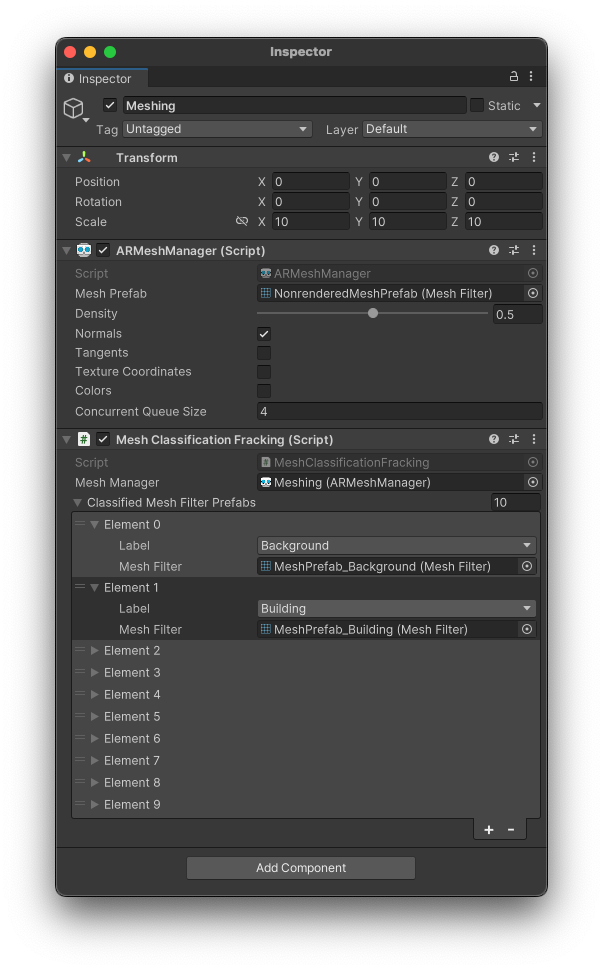Mesh Classification
The Mesh Classification feature within the XREAL SDK enables the segmentation and classification of real-world surfaces into predefined categories (such as floors, walls, or ceilings) using AR Foundation. This capability is essential for applications that require contextual awareness of their environment, allowing for more accurate placement and interaction of virtual objects.
Developer Guide
This guide will walk you through implementing Mesh Classification using the XREAL SDK in combination with AR Foundation. The guide covers project setup, mesh scanning, classification, interaction, reclassification, and clearing classified meshes.
Project Setup
Before using Mesh Classification, ensure your project is properly configured. Refer to the Getting Started with XREAL SDK guide for the necessary setup. Once set up, locate the “AR Feature” sample, specifically the Mesh Classification scene, and build it. You can also modify this sample to suit your needs.
If you want to add mesh classification to an existing scene:
After following the setup instructions in the Getting Started with XREAL SDK guide, locate the XR Interaction Setup->XR Origin in your scene. Create an empty GameObject as a child of this Prefab, which you can name MeshingManager, and add the AR Meshing Manager Component.
To use meshing with AR Foundation, add the ARMeshManager component to a child GameObject of your scene's XR Origin.

The ARMeshManager must be a child of the XROrigin.
Then, add the Mesh Classification Tracking (Script) component to this MeshingManager. This script can classify Meshes into 10 categories (Background, Wall, Build, etc.). You can add different mesh Prefabs for each category to distinguish between them.

Implementation
Classified Mesh Filter Prefabs
The Classified Mesh Filter Prefabs define the available semantic labels and the prefabs used to represent each classified mesh. These labels help in categorizing different parts of the environment, allowing the system to recognize and interact with various surfaces accurately.
Available Semantic Labels:
The following semantic labels are defined in the NRMeshingVertexSemanticLabel enum. Each label corresponds to a different type of surface or object that the meshing system can classify:
public enum NRMeshingVertexSemanticLabel : byte
{
Background = 0, // General background surfaces
Wall = 1, // Vertical surfaces like walls
Building = 2, // Structural surfaces part of a building
Floor = 4, // Horizontal surfaces like floors
Ceiling = 5, // Overhead surfaces like ceilings
Highway = 6, // Road surfaces
Sidewalk = 7, // Pavement or sidewalk surfaces
Grass = 8, // Natural surfaces covered with grass
Door = 10, // Door surfaces
Table = 11, // Furniture surfaces like tables
}
Each semantic label can be associated with a different prefab to visually represent the classified mesh in the scene. By assigning specific prefabs to these labels, you can easily differentiate between different types of surfaces within the AR environment.
Start Mesh Classification
To start the mesh classification process, initialize the AR environment and start scanning for surfaces. The scanned meshes will automatically be classified into predefined categories.
public void StartClassification()
{
// Begin scanning and classifying the environment
m_MeshClassifier.StartScanning();
}
Display Classification Results
Once the meshes are classified, you can display the results to the user. Each classified surface type can be rendered in a different color or material for easy identification.
Reclassify Meshes
If the environment has changed or you want to update the classifications, re-trigger the classification process.
public void ReclassifyMeshes()
{
m_MeshClassifier.ClearClassifications();
StartClassification();
}
Clear Classified Meshes
To clear all classified meshes from the scene:
public void ClearAllClassifications()
{
m_MeshClassifier.ClearClassifications();
}
Further Reading
For more detailed information on working with mesh classification and related AR features, refer to the official AR Foundation Documentation.